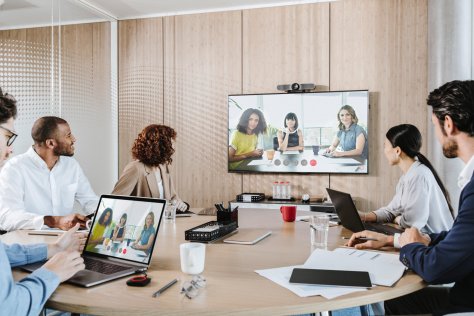A major survey of white-collar workers around the world, published today by Barco, global leader in visualisation and collaboration solutions, has revealed surprising findings about employee expectations for the workplace in the aftermath of the COVID-19 pandemic.
The study – which surveyed 1,750 employees around the world (250 each from the United States, United Kingdom, France, Germany, Australia, India and United Arab Emirates) through global research panel provider Dynata – found that only 15 percent of employees want to continue to work from home full-time after COVID-19 restrictions are lifted.
It also found that nearly half of those surveyed said they enjoy working from home less now than they did at the start of the pandemic, citing challenges in collaborating with colleagues, struggling to contribute to meetings and missing the social side of office life as the main reasons for wanting to return to the office.
The survey results suggest many have suffered as a result of being separated from their colleagues, both emotionally and in their work. 49 percent globally said they have found working from home less fun as time has passed. 37 percent said they miss office social life and found it harder to collaborate when working remotely. 29 percent said they found it difficult to contribute to meetings, while 28 percent said they get easily distracted at home.
Collaboration and socialising were unsurprisingly the main reasons people wanted to get back to the office: 45 percent said they found it easier to work with colleagues in the office, and the same percentage said they liked the social aspect of office life. 44 percent also highlighted the importance of those ‘water cooler moments’ – the informal interactions where colleagues spontaneously share information – in not just improving productivity and collaboration, but also in adding to the social side of working life.
The study shows that most employees think that we are already returning to something resembling normality after COVID-19, with the number of remote-only meetings expected to drop significantly and hybrid meetings set to become the norm.
The findings also suggested that huddle spaces might be out, after a huge trend towards these informal meeting areas in previous years. 50 percent of respondents said they prefer formal meeting rooms now, and 75 percent prefer scheduled meetings over impromptu ones.
Most employees still prefer to spend most of their time at a large corporate headquarters, albeit now with more flexibility to work from home some of the time.
Asked where they would most like to see their employers invest, respondents chose video conferencing equipment for use in meeting rooms as their preferred destination for new investment in future. The findings may seem surprising at first glance, until you look at how prevalent the use of video conferencing technology has become and the fundamental role it now plays in collaboration, communication and productivity for a digitally driven workforce.
After standard meeting rooms, video conferencing rooms are the most commonly used spaces in the office. 77 percent of respondents said they use video conferencing rooms at least once a week, with 28 percent using them every day on average.
The ‘Bring Your Own Meeting’ trend that was growing before COVID-19 – where employees not only want to use their own devices (Bring Your Own Device), but also their own preferred conferencing solutions – has continued apace during the pandemic. Indeed, the results of the study show that the laptop is now the single most important thing in most employees working lives: 77 percent said they couldn’t bear to be parted from it while at work.
56 percent of employees prefer to host video calls from their laptop, compared to 19 percent who prefer in-room systems and 18 percent who like to use their smartphone.
Despite the growth of in-room camera use (traditional in-room conferencing systems and USB-based SWAPs) from 30 percent now to 40 percent in one year’s time, 54 percent of employees still use their laptop camera even when they are in a meeting room. Clearly, however, this is a sub-par experience because more than 60 percent of respondents complained of camera malfunctions during meetings.
Lieven Bertier, Segment Marketing Director Workplace, Barco, said, “There is now a burning desire from employees to get back to normal. 85 percent of the workforce wants to return to the office and resume the collaborative and social aspect of working life that they have missed so much, albeit with the freedom, flexibility and facilities to adopt a better blend of home and office working.”
He added, “Technology will be crucial to achieving this blend. The message comes through loud and clear from our survey: of all the things office works want their companies to invest in, collaboration technologies are top of the list. To survive, rebuild and eventually thrive again in the post-pandemic world, businesses will need to invest in new technologies, redesign or at least reconfigure their office spaces, and give their employees the tools they need to work in the best way possible, no matter where they are located or how they choose to connect. If they can make these changes quickly and effectively, they will be fit for the future and ready to deal with the challenges we all face over the coming months and years, and to seize the opportunities that will surely follow.”





